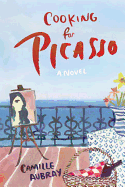
In the spring of 1936, Pablo Picasso retreated from Parisian society to the village of Juan-les-Pins on the French Riviera. In the solitude of a hilltop villa, he began working again after a creative dry spell, producing, among others, several paintings of an unknown young woman. In her fifth novel, Cooking for Picasso, Camille Aubray gives the woman a name--Ondine Belange--and unfolds a story of food, art and family secrets stretching across generations.
Aubray (previously published as C.A. Belmond) tells both Ondine's story and that of her granddaughter, Céline, a Hollywood makeup artist who was born on the day her grandmother died. When Céline's mother, Julie, falls ill after revealing the family's connection to Picasso, Céline hops a plane to the French Riviera to find out more. Meanwhile, Aubray recounts how Ondine becomes first Picasso's personal chef and then his model, while longing for a life beyond her village.
Ondine is an appealing protagonist, and her naïveté provides an excellent way for Aubray to emphasize the shocking nature of Picasso's art and his love life. Céline is equally naïve, though less appealing; almost all of Aubray's female characters (except Céline's plucky Aunt Matilda) are frustratingly passive. The novel's descriptions of food are mouthwatering, however, and Picasso himself is bold and engaging, a man of outsized passions. Although the plot feels a bit rushed at times, Aubray's novel provides an entertaining getaway for art lovers and Francophiles. --Katie Noah Gibson, blogger at Cakes, Tea and Dreams

